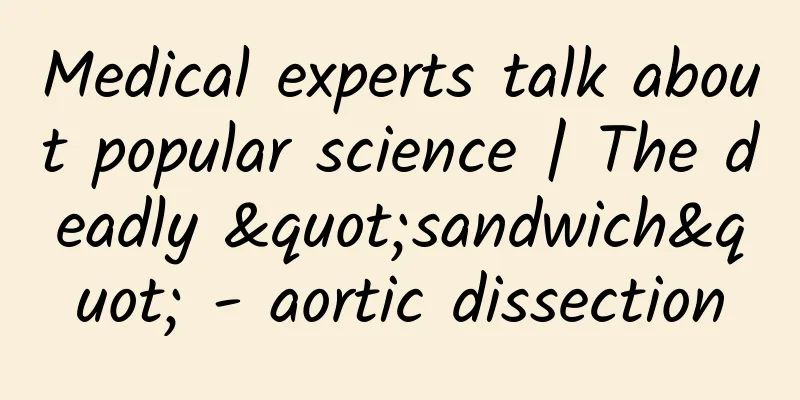Medical experts talk about popular science | The deadly "sandwich" - aortic dissection

|
| What is the aorta? The aorta is a "highway" that is sent out from the heart and transports blood to the whole body. The blood supply of the whole body passes through the aorta, and the aorta wall is composed of three layers: the intima, the middle layer and the adventitia. (Pictures from the Internet) | What is aortic dissection? Aortic dissection refers to a condition in which the aortic intima is torn due to some reason. Blood enters the middle layer of the arterial wall through the tear, causing the aortic wall to separate into true and false lumens. Blood spreads along the aortic wall and may affect the ascending aorta, thoracic aorta, and even the abdominal aorta and its branches. It is characterized by rapid onset, rapid progression, and high mortality rate, and is considered the most dangerous "killer" clinically. The original true lumen of the aorta and the torn false lumen are layered like a "sandwich", and are often called a "death sandwich". Aortic dissection is generally divided into Stanford type A and Stanford type B. As long as the dissection involves the ascending aorta, it is Stanford type A aortic dissection, while Stanford type B generally only involves the descending aorta. Stanford Model A Stanford Type B (Pictures from the Internet) | What are the common symptoms of fatal "killers"? l Chest pain: Pain is the most common symptom of aortic dissection. Sudden tearing pain in the chest, back, or abdomen may occur when lifting heavy objects, playing basketball, coughing suddenly, or straining to defecate. l Hypertension: Most patients have hypertension when they develop the disease, and there may be a large difference in blood pressure between the two upper limbs or between the upper and lower limbs. Most patients already have hypertension as a basic disease, and the pain of the dissection further increases blood pressure. l Organ or limb ischemia: Dissection may affect the blood supply to the aortic branch vessels such as the brain, heart, intestines, kidneys, lower limbs, etc., often manifested as cerebral infarction, myocardial infarction, abdominal pain, jaundice, bloody stools, oliguria or anuria, and severe ischemia of the lower limbs. l Dissection rupture: Rupture of aortic dissection leads to massive blood loss, which is the main cause of death from dissection. When a dissection ruptures, in addition to severe chest pain, there will be symptoms such as decreased blood pressure, pale face, cold sweat, and cyanotic lips. If the dissection ruptures into the pericardium, it will manifest as pericardial tamponade; if it ruptures into the chest cavity, it will manifest as dyspnea; if it ruptures into the esophagus, it will manifest as vomiting blood; if it ruptures into the trachea, it will manifest as hemoptysis. Dissection rupture is often accompanied by the patient's death. | What should I do if I suspect I have aortic dissection? 1. Strictly brake. 2. Effective analgesia. 3. Control blood pressure and heart rate. 4. Seek emergency medical attention. | What are the treatments for aortic dissection? 1. Thoracotomy: The operation is performed under general anesthesia, with a midline incision in the chest, and the diseased aorta is removed and replaced with an artificial blood vessel. The operation is difficult, time-consuming, and risky. It is suitable for Stanford A type aortic dissection. (Pictures from the Internet) 2. Minimally invasive interventional surgery: Insert an artificial covered stent through the femoral artery to cover and seal the rupture of the descending aortic dissection. The surgery is less invasive, less bleeding, and quicker to recover from. It is suitable for Stanford B type aortic dissection. (Pictures from the Internet) 3. Conservative drug treatment: control blood pressure, relieve pain, and calm down. Conservative drug treatment is often used for milder Stanford B type dissections or preoperative treatment, but there is a risk of dissection rupture. | What should I pay attention to after aortic dissection surgery? 1. Control blood pressure and heart rate, and take antihypertensive drugs regularly as prescribed by your doctor. 2. Improve your lifestyle, do moderate exercise, avoid strenuous exercise, eat a light diet low in salt and fat, avoid emotional excitement, and actively control blood lipids and blood sugar; 3. Regularly review aortic CTA. Author | Liu Kexiang Doctor of Medicine, professor, chief physician, doctoral supervisor. Currently serving as Party Secretary of the Second Hospital of Jilin University, Director of the Cardiovascular Disease Diagnosis and Treatment Center, and Director of the Jilin Province Large Vessel Disease Diagnosis and Treatment Center. National Young and Middle-aged Expert with Outstanding Contributions to Health Care, Professional and Technical Personnel with Outstanding Contributions to Jilin Province, and one of the Ten Bethune Famous Doctors of Jilin University. He is currently a standing member of the Thoracic and Cardiovascular Surgery Branch of the Chinese Medical Association, deputy group leader of the Large Vascular Group of the Thoracic and Cardiovascular Surgery Branch of the Chinese Medical Association, a standing member of the Cardiovascular Surgeons Branch of the Chinese Medical Association, deputy group leader of the Coronary Artery Group of the Cardiovascular Surgeons Branch of the Chinese Medical Association, a standing member of the Minimally Invasive Cardiovascular Surgery Professional Committee of the National Cardiovascular Disease Expert Committee, chairman of the Cardiovascular Surgery Branch of the Jilin Medical Association, chairman of the Cardiovascular Surgery Branch of the Jilin Medical Association, chairman of the Cardiac Surgery Branch of the Changchun Medical Association, a review expert of the National Natural Science Foundation of China, an editorial board member of the "Chinese Journal of Extracorporeal Circulation", a standing member of the Academic Committee of the "Chinese Journal of Clinical Physicians (Electronic Edition)" of the Chinese Medical Association, a standing editorial member of the "Chinese Cardiovascular Disease Research" Editorial Board, a corresponding editorial member of the "Journal of Cardiovascular Surgery (Electronic Edition)", and a member of the Editorial Board of "Journal of Jilin University (Medical Edition)". He was awarded the second "National Famous Doctor", the "Golden Knife Award" of the Cardiovascular Surgery Branch of the Chinese Medical Association, the National Advanced Individual of Returned Overseas Chinese and Their Families, the Jilin Province May 1st Labor Medal, the Young and Middle-aged Professional and Technical Talent with Outstanding Contributions to the Health System of Jilin Province, the Jilin Province Top Innovative Talent, the Jilin Province Outstanding Overseas Returned Talent Independent Innovation Award, the Outstanding Returned Study Student, the Changchun City May 1st Labor Medal, and the Individual with Outstanding Contributions to Changchun City's Health Work. He has invented 11 new surgical methods for treating large vessel diseases and coronary heart disease, which have been published in the international high-level journals Annals of Surgery (JCR Zone 1, IF=10.13), Journal of Thoracic and Cardiovascular Surgery (JCR Zone 1), and Annals of Thoracic Surgery (JCR Zone 2); the article included in Annals of Surgery, the highest-level journal in the international surgical field, is the first paper published in this journal by the cardiovascular surgery community in my country. He has undertaken more than 30 national and provincial and ministerial projects such as the National Natural Science Foundation of China, and built three provincial research centers and provincial key laboratories. He has won 4 national patents, 1 first prize for scientific and technological progress in Jilin Province, 1 second prize for Chinese Medical Science and Technology, 1 second prize for hospital scientific and technological innovation in the Chinese Hospital Association, 2 academic achievements in natural sciences in Jilin Province, and 16 medical achievements in Jilin University. He has published 1 monograph and more than 160 papers, including more than 70 papers included in SCI. He has trained more than 50 doctoral and master's students. | Discipline Introduction The Department of Cardiovascular Surgery of the Second Hospital of Jilin University is a professional discipline integrating medical treatment, teaching and scientific research. It is now the Jilin Province Large Vessel Disease Diagnosis and Treatment Center, the leading unit of the Jilin Province Large Vessel Disease Specialty Alliance, the Jilin Province International Science and Technology Cooperation Base, the Jilin Province Large Vessel Disease Precision Diagnosis and Treatment Engineering Laboratory, the Jilin Province Key Laboratory of Cardiovascular Disease, and the Jilin Province Large Vessel Disease Clinical Medicine Research Center. The discipline uses the most advanced international medical technology and has successfully carried out various cardiovascular surgical operations. It has successively filled the gaps in the field of cardiovascular surgery in the province and the country in many fields such as large vessel diseases, coronary heart disease, and surgical treatment of atrial fibrillation. The coronary surgery has reached the leading level in the country, and the large vessel field has reached the leading level in the world. In 2006, the first heart transplant operation in the province was completed independently. In 2005, the hospital was the first in the Northeast region to independently carry out surgical treatment of large vessel diseases; invented 8 new surgical methods; was the first in the world to use shallow hypothermic brain-body separation perfusion protection method and non-transfusion surgery to treat Stanford type A aortic dissection, and achieved the first non-transfusion surgical treatment of Stanford type A aortic dissection in the world; was the first in China to use ECMO after acute aortic dissection surgery. The hospital was the first in the province to independently carry out coronary artery bypass surgery; invented 2 new surgical methods; was the first in China to carry out full arterialization coronary artery bypass surgery, vein bridge sequential anastomosis bypass surgery and non-transfusion coronary artery bypass surgery. In 2005, the hospital was the first in China to use bipolar radiofrequency ablation modified Maze surgery to treat atrial fibrillation; in 2007, the hospital was the first in China to carry out surgical treatment of severe complex heart disease, and CCTV Science and Technology Channel did a special interview and report. The hospital carries out surgical treatment of various common and complex congenital heart diseases, as well as surgical treatment of congenital heart diseases in newborns, and invented 1 new surgical method. The hospital was the first in the world to perform minimally invasive small incision Stanford type A aortic dissection surgery; the first to perform minimally invasive heart surgery in the three northeastern provinces; the first in Jilin Province to perform fully thoracoscopic heart surgery, transaortic valve intervention (TAVI) surgery, ultrasound-guided atrial and ventricular septal defect closure and patent foramen ovale closure; and interventional stent-graft transluminal angioplasty (TEVAR) for descending thoracic aortic aneurysm, abdominal aortic aneurysm, and Stanford type B aortic dissection. |
<<: Cat scratch fever: a common zoonosis transmitted from pets
>>: What is the target value for blood lipid control?
Recommend
Little knowledge about white cardamom, cardamom and nutmeg
White cardamom, cardamom and nutmeg are all carda...
How to wear silicone invisible underwear
Silicone underwear is also very popular today, an...
Under what circumstances should salpingography be performed?
Generally speaking, women who have not been able ...
How should women with poor liver function treat their condition?
The liver is an important organ for detoxificatio...
How to treat vaginitis
One of the diseases that women fear the most is v...
What are the causes of breast atrophy after breastfeeding?
Breasts are one of the most important organs for ...
If you drool while sleeping, beware of these 4 diseases! Don't ignore them!
Many people will find their pillows wet with sali...
What to do if you have stomach pain due to uterine cold
Many women are prone to stomach pain, which has a...
What to do if your uterus prolapses after giving birth
After giving birth, new mothers are prone to uter...
Do soy products increase uric acid? Can soda water lower uric acid? What you know may not be the truth!
Author: Wang Hailong, Chief Physician, Dongzhimen...
How to shrink the belly quickly after cesarean section
Caesarean section is a common method of delivery ...
Sleep management during the COVID-19 epidemic prevention and control period
During the critical period of COVID-19 prevention...
Can carnation seedlings be planted in winter? When should carnations be planted?
Dianthus, also known as Luoyang Flower, is one of...
The secret of maintaining a woman's health at 25
I believe everyone knows the importance of mainte...
Vaginal dryness before menstruation
For female friends, menstruation is their good fr...









